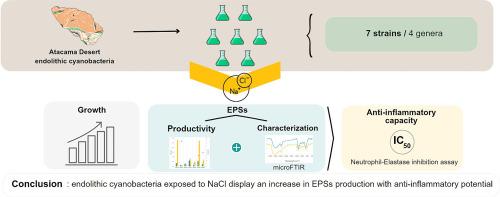Hidden inside desert rocks: Salinity triggers an increase in exopolysaccharides from endolithic cyanobacteria with anti-inflammatory potential
IF 4.6
2区 生物学
Q1 BIOTECHNOLOGY & APPLIED MICROBIOLOGY
Algal Research-Biomass Biofuels and Bioproducts
Pub Date : 2024-12-01
DOI:10.1016/j.algal.2024.103817
引用次数: 0
Abstract
Endolithic cyanobacteria thriving in rocks of deserts remain an unexplored source for the quest of novel bioproducts in extreme environments. In this work, 7 endolithic cyanobacteria from the polyextreme Atacama Desert, covering four genera and three lithic substrates, were investigated for the production of exopolysaccharides with anti-inflammatory potential. A moderate salinity (20 g NaCl L−1) was tolerated by all strains, triggering a 3–9-fold increase in exopolysaccharides (EPS) yield in 4 of them that counteracted the growth decrease due to NaCl stress. EPS from all strains showed anti-elastase activity with inter-strain and inter-salinity variations. The moderate EPS productivity by Gloeocapsa sp. UAM572 (0.4 mg EPS L−1 day−1), elevated anti-elastase capacity of Chroococcidiopsis sp. UAM579 EPS (IC50 = 78 μg mL−1) and the first biotechnological data of genus Pseudoacaryochloris, provide a promising foundation for potential applications of EPS from endolithic cyanobacteria in cosmetics and biomedicine, whose opportunities and challenges are discussed herein.

隐藏在沙漠岩石中:盐度引发具有抗炎潜力的内生蓝藻的外多糖增加
在沙漠岩石中蓬勃发展的内生蓝藻仍然是在极端环境中寻求新型生物产品的未开发来源。在这项工作中,研究了来自多极端阿塔卡马沙漠的7种内生蓝藻,涵盖4属和3种片状底物,以生产具有抗炎潜力的外多糖。所有菌株都能耐受中等盐度(20 g NaCl L−1),其中4株的胞外多糖(EPS)产量增加了3 - 9倍,抵消了NaCl胁迫导致的生长下降。所有菌株的EPS均表现出抗弹性酶活性,且菌株间和盐度间存在差异。Gloeocapsa sp. UAM572具有中等EPS产量(0.4 mg EPS L−1 day−1),Chroococcidiopsis sp. UAM579 EPS抗弹性酶能力(IC50 = 78 μg mL−1),以及Pseudoacaryochloris属的首次生物技术数据,为内生蓝藻EPS在化妆品和生物医药领域的潜在应用提供了良好的基础,本文讨论了其机遇和挑战。
本文章由计算机程序翻译,如有差异,请以英文原文为准。
求助全文
约1分钟内获得全文
求助全文
来源期刊

Algal Research-Biomass Biofuels and Bioproducts
BIOTECHNOLOGY & APPLIED MICROBIOLOGY-
CiteScore
9.40
自引率
7.80%
发文量
332
期刊介绍:
Algal Research is an international phycology journal covering all areas of emerging technologies in algae biology, biomass production, cultivation, harvesting, extraction, bioproducts, biorefinery, engineering, and econometrics. Algae is defined to include cyanobacteria, microalgae, and protists and symbionts of interest in biotechnology. The journal publishes original research and reviews for the following scope: algal biology, including but not exclusive to: phylogeny, biodiversity, molecular traits, metabolic regulation, and genetic engineering, algal cultivation, e.g. phototrophic systems, heterotrophic systems, and mixotrophic systems, algal harvesting and extraction systems, biotechnology to convert algal biomass and components into biofuels and bioproducts, e.g., nutraceuticals, pharmaceuticals, animal feed, plastics, etc. algal products and their economic assessment
 求助内容:
求助内容: 应助结果提醒方式:
应助结果提醒方式:


